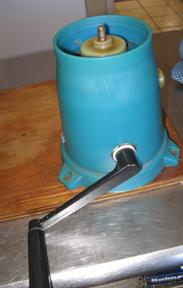Today I need to separate the cream
out of about 10 gallons of goats milk in anticipation of churning some goat
butter tomorrow.
Goats milk is quite different in
composition and construction than cow’s milk.
Take the cream, for example. With
unprocessed (specifically, not homogenized) cow’s milk, the cream will readily
rise to the surface if left alone for a few hours or overnight. Not so with goats milk.
Goats milk is said to be
"naturally homogenized" because the butter fat molecules in goats
milk are so much smaller by comparison
to those in cow’s milk, that they more easily stay suspended in the liquid.
(This coincidentally , is one of the reasons that goats milk is considered to
be much easier to digest than cow’s milk).
In order to get the cream out of
goats milk - either to obtain the cream for other use or to make a lower fat
milk product - it must be mechanically separated. Typically, the way this is done is with an
apparatus called a "cream separator" (imagine that!).
Cream separators come in many
sizes/capacities and can be successfully made from a number of different
materials but nearly all work on the same operating principle: centrifugal
force*. Even though the butter fat
molecules are small and in suspension they are still lighter than water (the
primary component of milk) and so the act of accelerated spinning works to
separate the fat from the milk. From that point all that is left to do is send
the butterfat-rich milk (cream) in one direction and the butterfat-poor milk
(skim milk) another.
Cream separators have lots of parts
that have to go together in just the correct order for it to work
properly. Mine, an old Russian-made,
hand crank model with predominantly plastic parts, has over 20 milk-contact
parts, plus the crank/transmission unit.
Here are several pictures of the
parts, the sub-assemblies, and final assembly...
To get the best results from a cream
separator the most important thing (aside from the correct assembly of all the
parts) is to have the milk at the proper temperature. I have found that 101-103 degrees F (which
happens to be a normal goat's body temperature) works best for goats milk. Too hot and it seems not to get all the cream
out of the milk. Too cool and it gums up
the separator plates, clogging up the works.
My unit has a set-screw adjustment that is supposed to let you make
heavy, medium, or light cream but it does not seem to have any effect when I
have tried it.
The actual separating is easy. Once the milk is to temperature it is poured
into the hopper. The crank is turned
at about 60 rpm (one revolution per second). The flag valve is
opened and a stream of milk flows to the bottom of the assembly of plates which, because of the gearing, are now spinning quite fast. The
milk flows through the plates which have a series of holes that direct the
heavier elements one way and the lighter another. The two streams of separated milk find their
way to the 2 spouts with a pretty good flow of skim milk going one way and a
smaller drizzle of cream the other.
My hopper takes about a gallon of
milk so it had to be refilled several times. DO NOT stop turning the crank when
there is milk flowing through the machine or it will make a huge mess by
flowing out everywhere except from where it is supposed to!
I normally expect to get about a
quart of cream from 4 gallons of milk but I had never separated cream at this
time of year. We know from both the milk
quality testing we do and the cheese yields we get, that our milk gets much
richer in the fall and winter than it is in the summer. We have individual goats who we know can produce milk with about 10% butterfat late in the year (by comparison, regular whole milk at the store is about 3.5% butterfat), but I was still surprised by my
yield.
Today I got 6 quarts of very heavy
cream from the 10 gallons of milk!
Tomorrow I will be churning all that
cream into Goats Milk Butter.
*Strictly speaking there is no such
thing as "centrifugal force". The force we commonly refer to as
centrifugal is actually the inverse or absence of "centripetal
force". Confused? Look it up. Here's a place to start... http://en.wikipedia.org/wiki/Centrifugal_force













No comments:
Post a Comment